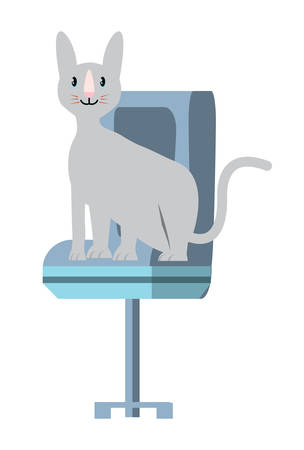Understanding Cat Mental Health
When we talk about mental health in cats, were referring to their emotional and psychological well-being. Just like people, cats can experience a range of emotions—from happiness and curiosity to stress and anxiety. Mental health in cats is often expressed through their behavior. For example, a mentally healthy cat typically shows interest in play, seeks affection, and interacts confidently with its environment. On the other hand, a cat experiencing mental health challenges might hide more than usual, become aggressive, over-groom, or even stop eating. Why does this matter? Because a cat’s mental state directly impacts its overall quality of life and can influence physical health as well. When your cat feels safe and content, it’s more likely to stay active and maintain healthy habits. Understanding your cat’s mental health is the first step in providing comprehensive care that supports both mind and body.
2. Physical Health: More Than Just the Obvious
When we think about a cat’s health, most people picture shiny coats, clear eyes, or a healthy weight. But physical health in cats goes much deeper—and often overlaps with their mental well-being. Some key physical health markers can actually reveal a lot about your cat’s emotional state and vice versa. Here’s how these two worlds connect.
Key Physical Health Markers in Cats
| Physical Marker | What It Indicates | Mental Health Connection |
|---|---|---|
| Appetite & Eating Habits | Steady appetite and regular eating patterns show good health. | Cats with anxiety or depression may eat less or overeat. |
| Grooming Behavior | A clean, well-groomed coat signals self-care. | Over-grooming or neglecting grooming can signal stress or emotional distress. |
| Litter Box Use | Consistent litter box habits reflect physical comfort. | Sudden changes often point to anxiety, fear, or environmental stressors. |
| Activity Level | Active play and movement mean strong muscles and joints. | Lethargy or hyperactivity can be symptoms of emotional imbalance. |
| Body Weight & Condition | Healthy weight shows balanced nutrition and activity. | Obesity or sudden weight loss may be linked to boredom, stress, or depression. |
The Overlap: Why Both Matter Equally
In many cases, it’s tough to separate physical from mental health in cats. For example, a cat that suddenly stops using the litter box might have a urinary tract infection—or it could be reacting to recent changes at home. Similarly, chronic pain from arthritis can make a cat anxious or withdrawn. By monitoring both physical and behavioral changes, you get a fuller picture of your pet’s total well-being. Addressing only one side can lead to missed warning signs and unresolved problems. Recognizing this overlap is key to keeping your cat truly healthy—inside and out.

3. How Mental Health Impacts Physical Health
Just like humans, cats’ mental well-being can dramatically influence their physical health. When a cat experiences chronic stress or anxiety, it often manifests through a variety of physical symptoms. Let’s look at some real-life examples that show how closely linked mental and physical health are in our feline companions.
Overeating and Weight Gain
Consider a housecat named Bella, who started overeating after her owner went back to work full-time. Bella’s anxiety about being alone led her to seek comfort in food, resulting in rapid weight gain and increased risk for diabetes. This example is common among American households where owners have busy schedules, highlighting the need to pay attention to changes in eating habits as possible signs of emotional distress.
Hair Loss and Over-Grooming
Another case is Max, an adopted shelter cat who developed bald spots on his belly and legs. After several vet visits, it turned out that Max was over-grooming due to anxiety about his new environment. Cats often lick themselves excessively as a coping mechanism when they feel stressed or insecure, which can lead to hair loss and even skin infections if left untreated.
Digestive Problems
Mental health issues can also impact the digestive system. For example, Luna, a tabby living in a multi-cat household, began having frequent bouts of diarrhea whenever there was conflict with other cats. Her stress response triggered gastrointestinal upset—a phenomenon veterinarians call “stress colitis.” In these scenarios, addressing the underlying emotional triggers is just as important as treating the physical symptoms.
The Takeaway
These real-world examples make it clear: when a cat is struggling mentally, you may see warning signs physically. By recognizing the connection between mental and physical health, cat owners can take proactive steps—like providing enrichment activities or reducing stressful changes—to ensure their pets’ overall well-being.
4. Physical Symptoms with Mental Roots
It’s easy to assume that issues like joint pain, obesity, or a dull coat in cats are purely physical problems. However, mental health plays a surprising role in these conditions. Let’s explore some real-life scenarios where what looks like a physical ailment is actually rooted in a cat’s emotional state.
Joint Pain Triggered by Stress
Cats experiencing chronic anxiety or stress may develop muscle tension from constantly being on high alert. This tension can exacerbate existing arthritis or even create the appearance of joint pain where none existed before. For example, a cat that feels threatened by household changes might spend more time hiding and less time moving around, which can lead to stiff joints and decreased mobility.
Obesity Linked to Emotional Wellbeing
Emotional eating isn’t just a human problem—cats can also overeat when they are bored, lonely, or anxious. A cat left alone for long hours might eat simply out of boredom, quickly leading to weight gain and obesity-related health issues such as diabetes and heart disease.
Common Emotional Triggers for Overeating
| Trigger | Resulting Behavior |
|---|---|
| Lack of stimulation | Eating more to pass the time |
| Loneliness | Seeking comfort in food |
| Household stress (new pets, moving) | Binge eating due to anxiety |
Poor Coat Quality as a Mental Health Indicator
A healthy cat’s coat should be shiny and soft. When cats experience depression or chronic stress, they may stop grooming themselves properly. This neglect leads to matted fur, dandruff, and an overall unhealthy appearance. In severe cases, cats may even over-groom certain areas as a coping mechanism, resulting in bald spots or skin irritation.
Case Example: The Cat Who Stopped Grooming
Molly, a six-year-old tabby, began developing patches of dull fur after her owner started working longer hours. The vet found no medical cause. With some changes—more playtime and interactive feeding toys—Molly’s mood improved, and so did her coat.
The takeaway? If your cat has unexplained physical symptoms like joint pain, weight gain, or poor coat condition, don’t overlook the possibility of underlying mental health issues. Addressing both mind and body can help your feline friend thrive.
5. Signs to Watch For: Spotting the Connection
When it comes to your cat’s well-being, behavioral changes can be the first clue that something deeper is going on. American cat parents should pay close attention to their pet’s daily habits, as shifts in mood or activity may signal both mental and physical health issues. For example, if your usually playful kitty becomes withdrawn or stops interacting with family members, it could point to underlying pain or stress. Likewise, excessive grooming or sudden aggression might be tied to anxiety or discomfort from a medical problem. Don’t ignore subtle cues—changes in appetite, litter box habits, vocalization, and sleep patterns all provide insight into your cat’s overall health. Practical tip: Keep a simple journal of your cat’s behavior and any changes you notice. This record will be invaluable when talking with your vet. If you spot any persistent differences—like hiding more often, increased irritability, or loss of interest in favorite activities—schedule a checkup right away. Early detection and intervention can make all the difference for your feline friend’s happiness and longevity.
6. Supporting Your Cat’s Mind and Body
Taking care of your cat’s mental and physical health goes hand-in-hand. By taking proactive steps, you can help your furry friend lead a happier, healthier life. Here are some practical ways to support both their mind and body:
Environmental Enrichment
Cats are naturally curious and need stimulation to stay mentally sharp. Provide a variety of toys, scratching posts, and interactive play sessions. Puzzle feeders or treat-dispensing toys can make mealtime more interesting while also encouraging healthy movement. Consider setting up window perches so your cat can watch birds or outdoor activity—this simple addition can reduce boredom and stress.
Regular Vet Visits
Annual checkups aren’t just about vaccines—they’re essential for catching health issues early, including those related to stress or anxiety. Your vet can help you recognize subtle signs of both physical illness and mental distress, like changes in appetite or grooming habits. Consistent medical care is a cornerstone of overall well-being.
Create a Safe Space
Cats feel secure when they have a quiet retreat, especially in busy households. Set up a cozy bed in a low-traffic area where your cat can relax undisturbed. This helps lower stress levels, which benefits their immune system and general health.
Routine and Predictability
Cats thrive on routine. Feed them at the same times each day and keep their environment as predictable as possible. Sudden changes can cause anxiety, which may manifest physically through digestive issues or behavioral changes.
Build Positive Interactions
Spend quality time with your cat every day. Gentle petting, play, or even talking to them strengthens your bond and reassures them emotionally. A cat that feels loved and secure is less likely to develop stress-related health problems.
By focusing on these actionable steps, you’ll be supporting not only your cat’s physical health but also their emotional well-being—a win-win for both you and your feline companion.
7. When to Call the Vet: Knowing the Red Flags
As a responsible cat owner in the U.S., it’s vital to recognize when changes in your cat’s mental or physical health need professional attention. Sometimes, subtle shifts in behavior can signal deeper health issues that shouldn’t be ignored.
Behavioral Changes That Need Attention
If your usually playful cat becomes withdrawn, aggressive, or unusually vocal, it might be more than just a mood swing. Look out for signs like loss of interest in toys, hiding more than usual, sudden fearfulness, or compulsive behaviors such as over-grooming. These can be red flags indicating stress, anxiety, or underlying medical conditions.
Physical Symptoms Not to Ignore
Cats are experts at hiding illness. Watch for changes in appetite, unexplained weight loss or gain, vomiting, diarrhea, coughing, sneezing, or labored breathing. Any significant shift in litter box habits—like urinating outside the box or frequent trips with little output—can indicate both physical and emotional distress. If you notice limping, lethargy, or difficulty jumping onto surfaces they previously managed with ease, consult your vet.
When Behavioral and Physical Signs Overlap
Sometimes behavioral and physical symptoms appear together. For example, a cat with dental pain may become irritable and stop eating; a stressed cat might develop gastrointestinal issues. In these cases, don’t wait and see—combined changes often point to more serious health concerns that need timely intervention.
What U.S. Cat Owners Should Do
If you observe any of these red flags lasting more than 24-48 hours, call your veterinarian. American veterinary clinics are experienced with both physical ailments and mental health issues in pets. They can help determine if your cat needs medical treatment, behavior modification strategies, or both. Early intervention not only improves outcomes but also strengthens the bond between you and your feline friend.
In short: Trust your instincts. If something feels off with your cat’s behavior or health, reaching out to a vet is always the right move.

